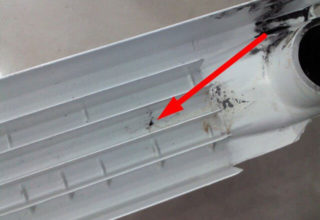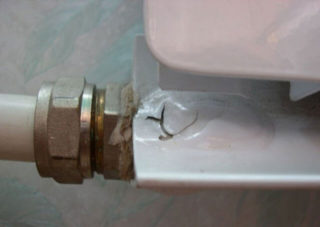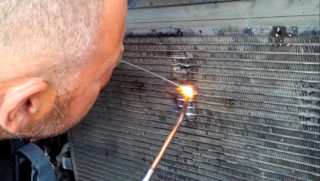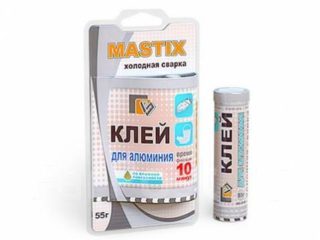Aluminum is a common metal that combines many remarkable qualities, including a high thermal conductivity with a relatively small mass. But this material, which is in demand in everyday life and in production, has one significant drawback - it easily reacts with other elements. This property significantly complicates the soldering of automobile cooling radiators, for example, and also leads to difficulties when you need to brew a heating battery.
Is it possible to solder aluminum radiators
Due to the activity of aluminum on its surface there is always a film of oxides, which prevents the connection with other metals. Therefore, the soldering of radiators based on it for most car owners and ordinary users seems to be a very serious problem.
It is possible to obtain high-quality and reliable compounds of aluminum with another metal only after heating the contact point to a high temperature.
In the process of heating the surface, a layer of protective oxides is also formed that do not allow even a small structural element to be soldered to it. Therefore, when soldering this metal, special fluxes are used to remove the film from the processing site. They include bismuth, cadmium or zinc. Only with their help it is possible to clean the surface of the welded metal and make it available for working solders.
The cost of branded fluxes with guaranteed quality is too high. For this reason, home craftsmen prefer to make such compositions (fluxes) on their own. Subject to the proportions indicated in the instructions, do-it-yourself solders are not inferior to branded compounds and sometimes surpass them in terms of effectiveness.
What is used for soldering
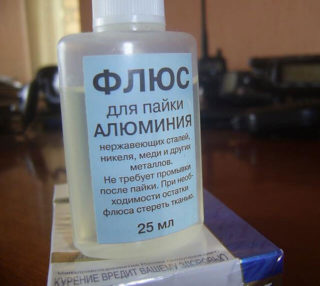 Before soldering aluminum radiators in a proven way, it is important to understand the main components used in the soldering process. For high-quality restoration of the damaged area, it is necessary to use solders with additives of silicon, zinc and a small amount of copper. They can be made independently or purchased in a specialized store.
Before soldering aluminum radiators in a proven way, it is important to understand the main components used in the soldering process. For high-quality restoration of the damaged area, it is necessary to use solders with additives of silicon, zinc and a small amount of copper. They can be made independently or purchased in a specialized store.
Consumables on the market are represented by standard bars of the TsOP-40 brand, according to GOST, having the following composition:
- tin;
- zinc;
- aluminum;
- silicon and copper.
The elements included in the solder (especially zinc) provide high strength of the resulting compound, as well as guarantee its corrosion protection. With its help, it is possible to solder small structural elements and large parts of aluminum radiators.
Soldering procedure
The proper organization of the aluminum brazing procedure involves thorough preparation, without which it will not be possible to achieve the desired result. Before you solder the radiator yourself, you should carefully read the relevant instructions. It indicates that the preparatory phase includes the cleaning of the restored area and the preparation of the soldering composition of the required quality.
Preparatory operations
Before soldering an aluminum radiator with a rosin-based flux, the damaged area is prepared according to the following instructions:
- Remains of the old coating and traces of contamination.
- The soldering area is cleaned with an abrasive.
- Immediately after this, it is degreased with a solvent.
Before soldering the radiator, you will need to prepare the flux in a metal crucible in advance. For this, rosin is first melted with a gas burner, after which small iron filings taken in a ratio of 1: 2 are added to the melt (they serve as an abrasive). At the same time, the prepared composition is mixed to a state of homogeneous mass.
The materials used in soldering are toxic and emit toxic fumes dangerous to humans. Therefore, all operations are carried out in the presence of a hood or in the open air. If it is not possible to fulfill these conditions, a working person will need a respirator.
Small defects elimination
 Upon completion of the preparatory operations, they proceed to the soldering process itself:
Upon completion of the preparatory operations, they proceed to the soldering process itself:
- A small amount of solder is captured with a soldering iron.
- In circular smooth movements, it is applied to a place previously treated with flux.
- During processing, it is important to carefully ensure that the solder layer is distributed evenly over the surface as much as possible.
When soldering, the sawdust contained in the solder cleans the oxides from the surface, and the rosin added earlier blocks the oxygen access channel. As a result, all conditions are created to obtain reliable contact between various metals. This method is only suitable for minor damage, the size of which does not exceed a few millimeters. In large areas, the flux cools quickly and does not provide good heating of the soldering place.
Repair significant damage
The need to restore a significant area of aluminum surfaces has to be encountered quite often. A special soldering compound called “fluff” is required. Before its use, preparation of the treated surface of the battery is carried out, as was done for small areas.
The initial components for the preparation of flux:
- potassium and lithium chlorides;
- common table salt;
- sodium sulfate;
- cryolite.
The mixture prepared in a certain proportion is first thoroughly ground in a mortar to the state of powder. After that, it is poured into a crucible, where it is thoroughly mixed to a homogeneous mass, suitable for obtaining a melt.
If the powder obtained is not immediately used for work, it is poured into a suitable container, closed with a tight stopper, and stored in a dark place.
The order of soldering using fluff:
- The damaged area is thoroughly heated by means of a gas burner.
- A portion of fluff is applied to the prepared area with a thin layer.
- Damage is soldered with tin-lead solder with the addition of small amounts of bismuth.
When working with special equipment (gas burner), it is important not to overheat the restored area, so as not to burn it. The flame strength is selected so that it is enough only for uniform heating of the surface of the aluminum product.
Repair of radiators of complex configuration
There may be situations when you need to restore (unsolder) the aluminum radiator of a car, which has many inaccessible places. In this case, methods based on the use of iron-rosin flux and self-made flux are not suitable. Thin-walled tubes of a copper or brass car radiator, for example, because of the design features, it is very difficult to solder. In this situation, it is recommended to use a low-temperature solder (NTP) with simultaneous sizing of the restored surface. The list of preparatory operations considered should add the need for pliers to crimp the damaged portion of the radiator or stove, which will reduce the size of the hole.
In the course of soldering, the treated zone is first thoroughly heated by a gas burner, after which an NTP bar is introduced into its flame.Periodically conducting them in this place, you need to try to make sure that the solder particles cling to the edges of the damage and gradually "tighten" it. At the final stage, it will be necessary to seal the defect zone using a special high-temperature glue. With its help, it is possible to “patch up” all the remaining minor irregularities and flaws.
Using cold welding and glue
When you need to repair minor damage or to repair a small chip on the surface of the part, it is best to use an adhesive called cold welding. It is a special mixture with a high degree of plasticity, and made on the basis of epoxy resin - a polymer with unique strength characteristics. In addition, the composition of "cold welding" includes various fillers (sulfur and plasticizers), which further increase this indicator.
Most often, it is produced in the form of two plastic bars, outwardly resembling children's plasticine. Before use, they are simultaneously flexed with the fingers, resulting in the desired mixture of two components. To glue the damaged place, it is enough to separate a small piece of mashed mass and apply it to a previously prepared surface.
Any of the ways to restore aluminum radiators can be implemented without the help of unauthorized persons. However, if there is no complete confidence in your own abilities, it is best to contact a specialized car repair shop.
